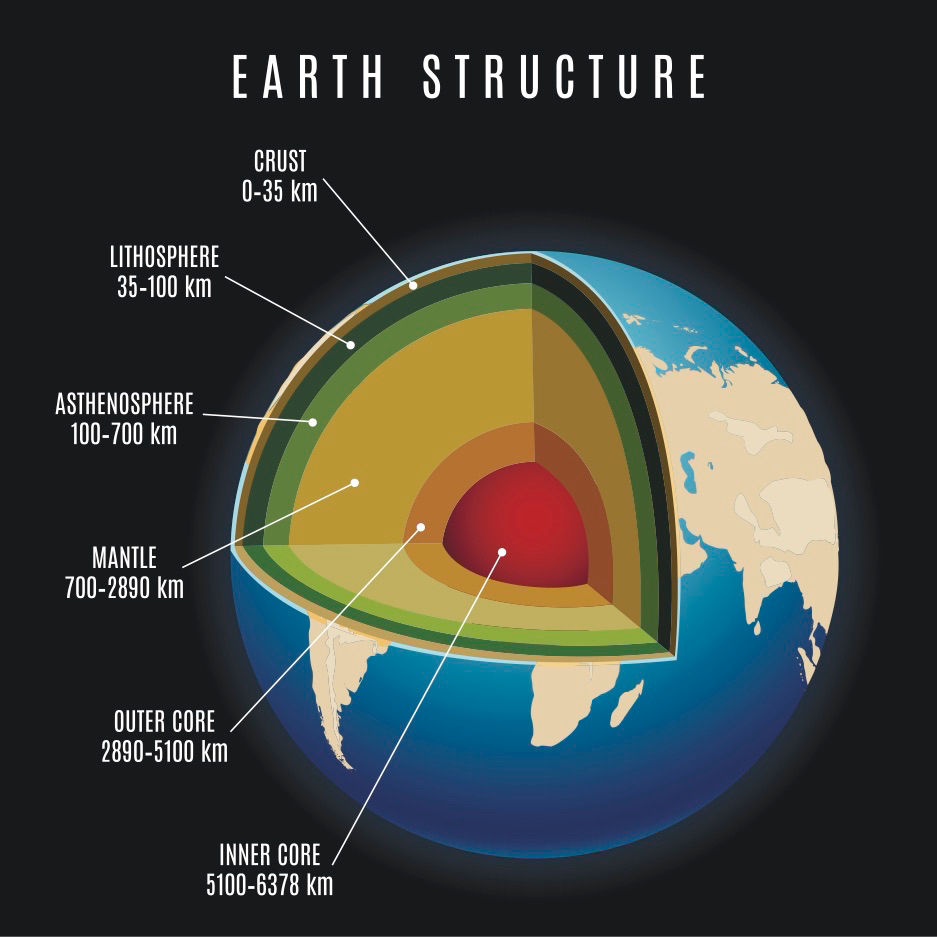How hot are Earth's scorching insides? A sweltering 2,570 degrees Fahrenheit (1,410 degrees Celsius), a new study finds.
The discovery reveals that the mantle under Earth's oceans — the area just below the crust that extends down to the planet's inner liquid core — is almost 110 degrees F (60 degrees C) hotter than scientists previously thought, the researchers said. The finding will help scientists more accurately model Earth's many geodynamic processes, including plate tectonics, they said.
"Having such a hot mantle could mean that the mantle is less viscous (flows more easily), which could explain how tectonic plates are able to move on top of the asthenosphere," the upper layer of Earth's mantle, said study lead researcher Emily Sarafian, a doctoral student in the Geology and Geophysics Department at a joint program run by the Massachusetts Institute of Technology and the Woods Hole Oceanographic Institution.
The temperature's effect on the asthenosphere isn't very different from that of hot temperatures on honey, she said.
"If you put honey in the fridge for an hour, it will barely flow when you take it out," Sarafian said in an email to Live Science. "If, instead, you put honey on the stovetop, it will flow very easily, because it's hotter."
Mantle mystery
There are many clues that the mantle under Earth's oceans is blazing hot. For instance, it generates the lava that bursts out of underwater volcanoes. However, for obvious reasons, scientists can't travel to the mantle and directly measure the temperature at which it melts.
Instead, scientists create mantle rocks in laboratories by combining powders of mineral building blocks, Sarafian said.
"Once they have a synthetic mantle rock, they then subject the rock to mantle pressures and temperatures to determine the temperature at which the rock melts at a given pressure," she said. By increasing the temperature in small intervals and at different pressures, scientists can note exactly when their synthetic mantle rock melts — a condition known as mantle solidus.
But there's a major problem with this experiment: water.
Mantle rocks contain a small amount of water, but it's incredibly challenging to ensure that the correct amount of water is in these laboratory samples, Sarafian said. Moreover, the atmosphere contains water, "so your experiments are adsorbing some unknown amount of water, and they aren't completely dry," she said.
Scientists are aware of this problem, "but they were never able to quantify how much water was in their experiments because the mineral grains that grow during an experimental run at mantle pressures and temperatures are way too small to measure with current analytical techniques," Sarafian said.
Understandably, scientists need to account for water in these experiments, as water in rocks can lower the rocks' melting temperature. In the past, researchers opted to do their experiments on dry synthetic rock, and then mathematically add water to the equation, she said.
But, as Sarafian and her colleagues later found out, because of the water in the atmosphere, these "dry" experiments were not actually dry; rather they contained roughly the same amount of water that is in the mantle, she said. Thus, correcting the results by mathematically adding water was unnecessary and made the results inaccurate.
Olivine to the rescue
A mineral called olivine helped Sarafian and her colleagues solve the puzzle another way. Olivine grains are about the size of fine sand, and large enough that researchers can accurately measure water within the grains. In addition, olivine is a good candidate because it occurs naturally in the mantle, Sarafian said.
"We performed melting experiments the same way that previous scientists did, putting a synthetic rock to high pressure and temperatures, but by adding these grains to our experiments, we were giving ourselves a target that was large enough to analyze for water content," she said.
Conveniently, the sample ended up having the same amount of water as the mantle does, Sarafian said. This meant they didn't have to use any equations to correct their data, she said.
Their results suggested that the mantle melts when it is relatively close to the Earth's surface. That runs counter to another recent finding, which showed that the mantle actually melts deep beneath the Earth's surface.
"This had to mean that the accepted mantle temperature estimate was too low, and actually, the mantle is 60 [degrees] C (about 110 F) hotter," Sarafian said. "That's a very significant jump!"
The discovery is "an appreciable correction" for the temperature of the mantle under the ocean, Paul Asimow, a professor of geology and geochemistry at the California Institute of Technology who was not involved with the study, wrote in an accompanying commentary in the journal Science.
The finding "will change interpretations of geophysical observations of the asthenosphere worldwide," Asimow wrote.
Quelle: SC

